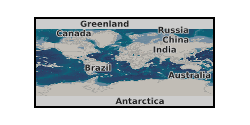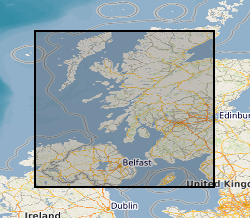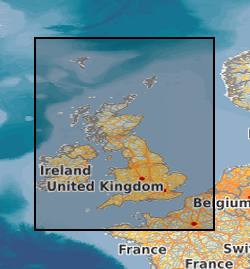Sediments
Type of resources
Available actions
Topics
Keywords
Contact for the resource
Provided by
Years
Formats
Representation types
Update frequencies
Scale
-

Sediment % coarse fraction (>63 microns), and abundance of fish teeth in coarse fraction. 2016 has been a record breaking year in terms of global temperatures. The high temperatures have resulted from a combination of elevated atmospheric pCO2 coupled with the global impacts of a strong El Nino event. There are many important components of the climate system, and the El Nino phenomenon demonstrates the importance of the low latitude Pacific Ocean. The warm pool of water in the western Pacific Ocean has not always had the same characteristics as it has today, and it has been proposed that its evolution over the past 15 million years has had a major impact on global climate. In order to understand how the warm pool might respond to future climate change, it is important to understand the drivers behind its past evolution. Did it respond simply to the changing shape of ocean basins through time? Or did it respond to other components of the climate system, such as sea level or latitudinal temperature gradients? The changes in warm pool structure may also have impacted the biological ecosystems, and hence the cycling of carbon in this region. The carbon cycle is another key component of the Earth's climate system. Understanding the causes and consequences of these long-term changes in the Pacific warm pool requires a two-pronged approach, using modelling in conjunction with proxy records for different parts of the climate system. This proposal aims to generate some key records of past high latitude temperature and ice volume that can be directly compared with changes in the warm pool through time. These records will be derived from geochemical analyses of microscopic marine fossils collected by the International Ocean Discovery Program (IODP).
-

Major, trace element and REE analyses of muds and mudstones from selected intervals from all of the holes. Location of the drill holes are given in the Exp. 352 cruise report (Reagan et al)
-

Through manufacturing, and geophysically characterising the properties and distribution of a range of synthetic gas hydrate morphologies in a range of sediments in the laboratory, protocols will be established for geophysically logging natural sediment-hydrate core preserved in pressure chambers on board ship. Based on pressure cycling, geophysical behaviour responses will be determined during the start of dissociation and formation. On this basis we then propose to develop protocols to characterise and classify hydrates sampled during ODP Leg 204, significantly improving our understanding of the nature and behaviour of these sediments. This new knowledge will enhance geophysical survey data, better constrain estimates of in-situ hydrates and improve the evaluation of hydrate destabilisation on methane release and slope stability.
-

Activity (dpm/g) of Uranium and thorium isotopes from 3 sediment cores in the North Atlantic: ODP980, ODP983, EW9302-2JPC. Ocean Drilling Program (ODP) Site 980 was drilled in July 1995 in the North Atlantic Ocean, on the Feni Drift, off the eastern edge of the Rockall Plateau at 55.49°N, 14.70°W. Hole 980A Position: 55°29.087'N, 14°42.134'W. Hole 980B Position: 55°29.094'N, 14°42.137'W. ODP Site 983 was drilled was drilled in July 1995 and is located on the Bjorn Drift in approximately 1650 m water depth on the eastern flank of the Reykjanes Ridge. Hole 983A Position: 60°24.200'N, 23°38.437'W. Site EW9302-2JPC, an ODP Site Survey in 1993, of Rockall Plateau and East Flank of Reykjanes Ridge from the Flemish Cap in the south- eastern Labrador Sea (Figure 1). EW9302-2JPC Position: 4847.700 N, 4505.090 W, taken at water depth 1251m.
-

Health and safety documentation for the Geophysical methodologies for the characterisation of gas hydrate core (HYDRAGAS) project.
-

Thermal and Alternating Field demagnetisation data from Carboniferous-age rock material from Cumbria and the Scottish Borders sampled in 2017. This data is divided into multiple four letter coded sections which refer to a specific locality and/or experiment type. BORD are alternating field demagnetisation results on volcanic material from the Scottish Borders, 330 million years old, sampled in the summer of 2017, carried out by Dr Courtney Sprain. BORR are thermal demagnetisation results on volcanic material from Burnmouth Harbour, Longhoughton Beach, Pease Bay, Joppa Shore, Sugar Sands Bay and Ross Beach in the Scottish Borders, 330 million years old, sampled in the summer of 2017, carried out by Dr Courtney Sprain. CMBR are thermal demagnetisation results on rock material from around Cumbria, 330 million years old, and sampled in Spring 2017, sampled and carried out by Dr Courtney Sprain and Dr Mark Hounslow. CUMB are alternating field demagnetisation results on rock material from around Cumbria, 330 million years old, and sampled in spring 2017, sampled and carried out by Dr Courtney Sprain and Dr Mark Hounslow.
-

Data collected as part of the NERC funded Radioactivity and the Environment (RATE), Long-lived Radionuclides in the Surface Environment (Lo-RISE), research consortium.This data comes from the marine workstream group based at the Scottish Universities Environmental Research Centre (SUERC) and the Scottish Association for Marine Science (SAMS). The data consists of radionuclide measurements of environmental and biological samples including radiocarbon, caesium (137), americium (241) and plutonium (238, 239, 240).The data has been published in the following publications: Tierney et al., 2018. Modelling Marine Trophic Transfer of Radiocarbon (14C) from a Nuclear Facility. Ecosystem Modelling and Software 102, 138-154. Tierney et al., 2017. Nuclear Reprocessing-Related Radiocarbon (14C) Uptake into UK Marine Mammals. Marine Pollution Bulletin 124, 43-50. Muir et al., 2017. Ecosystem Uptake and Transfer of Sellafield-Derived Radiocarbon (14C). Part 1: The Irish Sea. Marine Pollution Bulletin 114, 792-804. Tierney et al., 2017. Ecosystem Uptake and Transfer of Sellafield-Derived Radiocarbon (14C). Part 2: The West of Scotland. Marine Pollution Bulletin 115, 57-66 Tierney et al., 2016. Accumulation of Sellafield-derived 14C in Irish Sea and West of Scotland Intertidal Shells and Sediments. Journal of Environmental Radioactivity 151, 321-327.
-

Data are either (1) depths and spacings between stylolites and faults within Unit IV, (2) images from IODP drill core image logs of the locations of samples observed, (3) photomicrographs and flatbed thin section scans of thin sections cut from samples, (4) SEM BSE or EDS data collected at Cardiff University. These data form the basis of: Leah et al. "Brittle-ductile strain localisation and weakening in pelagic sediments seaward of the Hikurangi margin, New Zealand", Tectonics, Submitted. Images and data from samples collected at IODP Expedition 375 Site U1520 (38°58.1532'S, 179°7.9112'E, 3522.1 mbsl). This is just seaward (east) of the trench of the Hikurangi Margin, New Zealand.
-

The BGS Seabed Sediments 250k dataset is vector data which reflects the distribution of seabed substrate types of the UK and some of its adjacent waters (the UK Exclusive Economic Zone, EEZ) at 1:250,000 scale. This comprehensive dataset provides a digital compilation of the paper maps published by BGS at the same scale, as well as additional re-interpretations from regional geological studies. The seabed is commonly covered by sediments that form a veneer or thicker superficial layer of unconsolidated material above the bedrock. These sediments are classified based on their grain size, which reflects the environment in which they were deposited. This information is important to a range of stakeholders, including marine habitat mappers, marine spatial planners and offshore industries (in particular, the dredging and aggregate industries). This dataset was primarily based on seabed grab samples of the top 0.1 m, combined with cores, dredge samples and sidescan sonar acquired during mapping surveys since the early 1970s. Variations in data density are reflected in the detail of the mapping. The sediment divisions on the map are primarily based on particle size analysis (PSA) of both surface sediment samples and the uppermost sediments taken from shallow cores. Sediments are classified according to the modified Folk triangle classification (Folk, 1954, Journal of Geology, Vol. 62, pp 344–359). The modified Folk diagram and classification used by BGS differs from that created by Folk (1954) in that the boundary between 'no gravel' and 'slightly gravelly' is changed from trace (0.05%) to 1% weight of particles coarser than -1Ø (2mm), shown below. The boundaries between sediment classifications or types are delineated using sample station particle size analyses and descriptions, seafloor topography derived from shallow geophysical and, where available, multibeam bathymetry, backscatter and side-scan sonar profiles. This dataset was produced for use at 1:250 000 scale. These data should not be relied on for local or site-specific geology.
 NERC Data Catalogue Service
NERC Data Catalogue Service